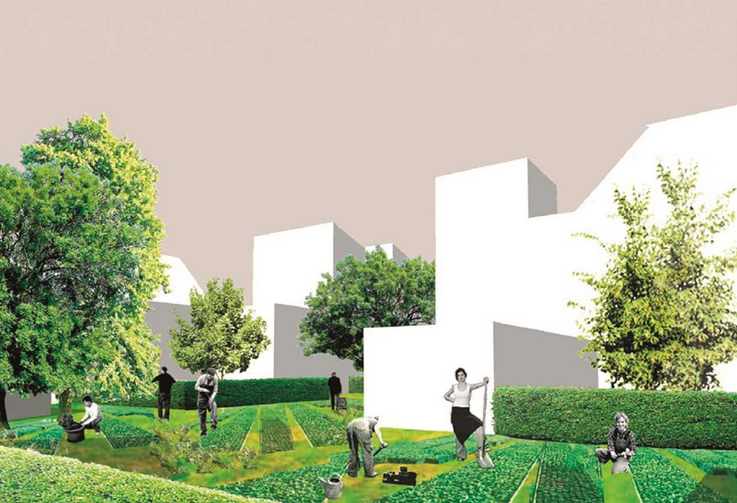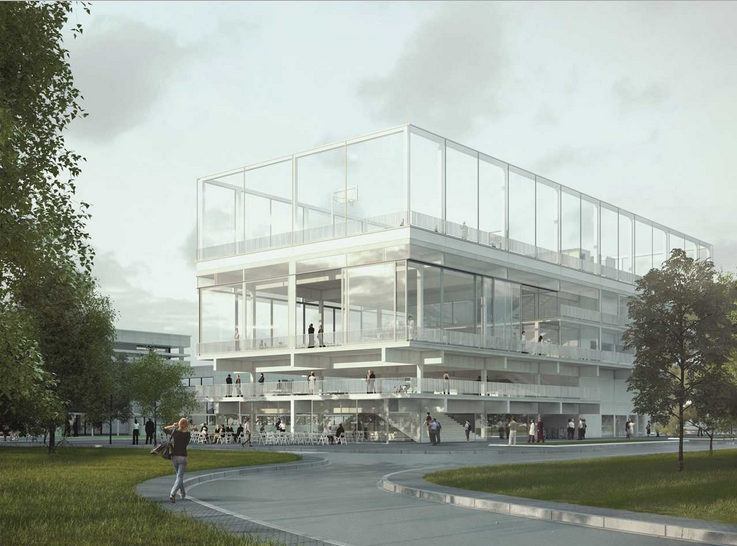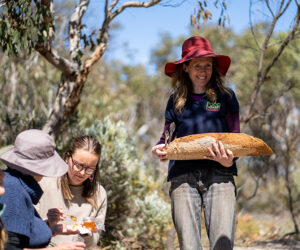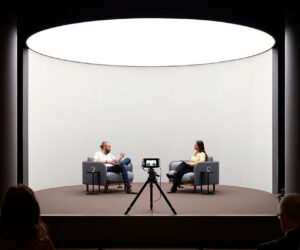Holcim Awards 2014 for Europe
The winning projects of the Holcim Awards 2014 for Europe illustrate how sustainable construction continues to evolve – developing more sophisticated and multi-disciplinary responses to the challenges facing the building and construction industry. An ecological reserve and remediation project in Southern Italy, a low-cost flexible university building in Paris, and a participatory urban neighborhood in Vienna won gold, silver and bronze.
A total of twelve projects including state-of-the-art designs from leading professionals as well as visions of the next generation were recognized and share more than USD 300,000 prize money. A jury of international experts led by Jean-Philippe Vassal (France) selected the winners using the “target issues” for sustainable construction that consider environmental, social and economic performance – while also highlighting the need for architectural excellence and a high degree of transferability.
Bold philosophical posture: Gold for an ecological reserve and remediation project in Saline Joniche, Italy
An environmental remediation project on the coast of Southern Italy that connects nature with the imprints of humanity won the top prize. Architects Francisco Leiva of Grupo aranea (Spain) and Marco Scarpinato of AutonomeForme (Italy) integrate the process of restoration in an area that has been degraded during the industrial age. The shape-shifting ecosystem generates a flooded landscape filled with flora and fauna, with a special focus on migrating birds.
At the prize handover event in Moscow, jury representative Arno Brandlhuber (Germany) applauded the Holcim Awards Gold winning project for its bold philosophical posture – investigating the roles of architecture, landscape design, and urban planning and their constraints through the necessity to allow human existence. “The project frames a discourse on potential forms of relationship between human activity and the natural environment, offering strategies for understanding architecture as a form of action in a symbiotic rapport with nature,” he said.
Remarkable merging of economics and aesthetics: Silver for a low-cost flexible university building in Paris, France
A building that will host a mix of activities including indoor and outdoor sports facilities, cafés, street terraces and a pedestrian square on the new university campus of Paris-Saclay received the Holcim Awards Silver. Gilles Delalex, Yves Moreau and Thomas Wessel-Cessieux from Muoto architects (France) have designed a minimal structure that uses rough materials, robust and long-lasting techniques, and vertical stacking to superimpose different activities above one another. The jury acknowledged the minimal deployment of architectural and technical means that is resilient and adaptable to future needs: “The elegant design merges economic and aesthetic considerations in such a way that the low-cost structure turns limitation into a quality”.
Focus on stakeholders: Bronze for participatory urban neighborhood in Vienna, Austria
An urban design project in Vienna that identifies a set of rules for establishing a sustainable urban neighborhood received the Holcim Awards Bronze. The urban plan by Enrique Arenas, Luis Basabe and Luis Palacios of Arenas Basabe Palacios arquitectos (Spain) uses a framework of gardens for the project’s physical and social development. The approach establishes a minimally-invasive intervention that will develop over time according to the needs of the community at every stage. The jury especially commended the focus on questions of procedures, including stakeholder participation and its effects on physical form: “The proposal offers a method for a step-by-step urban densification, combining both bottom-up/top-down and formal/informal practices to create an urban commons”.
Merging architectural and technical considerations: Honorable Mention to energy-efficient office building in Holderbank, Switzerland
A competence center including research labs, office space and training facilities, with a state-of-the-art energy concept received the first-ever Holcim Awards Honorable Mention. Designed by Swiss architect Christian Kerez, the perfectly circular atria cut through ceilings and floors crisscross the building, creating opportunities for employees and visitors to meet one another while also providing a sense of the building’s size from within. As the project was designed to become the new Competence Center of Holcim, the jury decided to bestow a non-monetary honorable mention “respecting the exceptional value of the proposal”.
Acknowledgement prizes for materials projects from Belgium and Germany
A team from TETRA architecten in Belgium received an Acknowledgement prize for their materials village in the Port of Brussels that distributes construction materials to the city, and also collects and recycles construction materials waste from the city. Karola Dierichs and Achim Menges from the University of Stuttgart’s Institute for Computational Design received an Acknowledgement for a multi-disciplinary materials research project that examines aggregate architectures made from injection-molding of designed, self-solidifying bioplastic granules.
“Next Generation” prizes for project visions in Austria, France, Ireland, Russia and Spain
The Holcim Awards competition also seeks visions and bold ideas in the “Next Generation” (young professionals and students) category. The jury decided to confer an unprecedented six prizes in recognition of the outstanding quality of submissions from across Europe. The “Next Generation” 1st prize, went to Hani Jaber, Ricardo Mayor, Héctor Muñoz, and Ignacio Taus of DAT Pangea (Spain) for a series of three socially-focused architectural designs. Their portfolio of projects includes a spatial plan and agricultural restructure, a productive urban garden as well as temporary spaces for public engagement. The jury was impressed by the design propositions that aim for a dialog between architecture and politics, taking key social problems into consideration while offering appropriate design solutions to address specific issues at hand.
The “Next Generation” 2nd prize was handed over to Aleksandr Veshniakov, Dimitry Ivanov, Natalia Mikhailova, Aleksandra Tyron, and Nadezhda Pavlova, a group of Russian architects, for a network of civic centers for small towns which form a virtual network using online connectivity. The jury was primarily interested in the idea of creating an “architectural instrument” that promotes vitality in small towns across Russia. The 3rd prize went to Iker Luna from Spain for a materials research project on moss-grafted clay tiles for green roofs. The material enables moss to grow on roof tiles, improving air quality and alleviating urban heat island effects. Additional “Next Generation” prizes were awarded to András Dankházi for a symbiotic water supply and landscape regeneration in Ireland (4th), Grégoir Arthuis for a high-rise tower rehabilitation in France (5th), and Nikola Znaor for a responsive sustainable shading system in Austria (6th).
Holcim Awards submissions for projects in Europe were evaluated by an independent jury hosted by the Swiss Federal Institute of Technology (ETH Zurich) and included: Jean-Philippe Vassal (Head of jury, France), Horia Adrian (Romania), Marc Angélil (Switzerland), Arno Brandlhuber (Germany), Antón García-Abril (Spain), Hiromi Hosoya (Switzerland), Hrvoje Njiric (Croatia), Stuart Smith (United Kingdom) and Holger Wallbaum (Sweden). www.holcimawards.org/jury-eur
Further information on the competition and each winning project including high resolution images for download is available at: www.holcimawards.org
The Holcim Awards ceremony in Moscow for the competition region Europe was the first presentation of winners in a series of events with others to be held in Toronto (for North America), Medellín (for Latin America), Beirut (for Africa Middle East) and Jakarta (for Asia Pacific). The projects that receive Holcim Awards Gold, Silver and Bronze in each region automatically qualify for the Global Holcim Awards 2015.
The Holcim Awards for Sustainable Construction competition seeks innovative, future-oriented and tangible construction projects to promote sustainable responses to the technological, environmental, socioeconomic and cultural issues affecting building and construction on a local, regional and global level. The competition has been run by the Swiss-based Holcim Foundation since 2004, offers USD 2 million in prize money per three-year cycle.
The Holcim Foundation is supported by Holcim Ltd and its Group companies in around 70 countries and is independent of its commercial interests. Holcim is one of the world’s leading suppliers of cement and aggregates (crushed stone, gravel and sand) as well as further activities such as ready-mix concrete and asphalt including services.
Holcim Awards 2014 prize-winning projects in Europe
Moscow, Russia – September 5, 2014
Main category
Holcim Awards Gold 2014 – USD 100,000
Anthropic Park: Freshwater ecological reserve and remediation, Saline Joniche, Italy
Main authors: Francisco Leiva, Grupo aranea, Alicante, Spain; Marco Scarpinato, AutonomeForme, Palermo, Italy. Further authors: Marta García Chico, Grupo aranea; Lucia Pierro, AutonomeForme
Holcim Awards Silver 2014 – USD 50,000
Public Condenser: Low-cost flexible university building, Paris, France
Main authors: Gilles Delalex, Yves Moreau and Thomas Wessel-Cessieux, Muoto, Paris, France. Further authors: Igrec Ingénierie; Bollinger + Grohmann Ingenieure; Alternative Acoustic & Lighting Consulting, all Paris, France; Novorest Ingénierie, Montreuil, France
Holcim Awards Bronze 2014 – USD 30,000
The Commons: Participatory urban neighborhood, Vienna, Austria
Main authors: Enrique Arenas, Luis Basabe and Luis Palacios, Arenas Basabe Palacios arquitectos, Madrid, Spain. Further authors: Christian Seethaler, Mascha & Seethaler; Thomas Proksch, Land in Sicht Landschaftsarchitektur; Robert Korab, Raum & Kommunikation; Andreas Käfer, Traffix Verkehrsplanung, all Vienna, Austria
Honorable Mention 2014 – special recognition
Circular Voids: Energy-efficient office building, Holderbank, Switzerland
Author: Christian Kerez, Christian Kerez AG, Zurich, Switzerland
Holcim Awards Acknowledgement prizes 2014 – each USD 25,000
Aggregate Structure: Reusable aggregates requiring no binding agent, Stuttgart, Germany
Authors: Karola Dierichs and Achim Menges, Institute for Computational Design, University of Stuttgart, Germany
Material Flows: Construction materials recycling and logistics hub, Brussels, Belgium
Main authors: Ana Castillo, Jan Terwecoren, Lieven De Groote and Annekatrien Verdickt, TETRA architecten, Brussels, Belgium. Further authors: Bjorn Gielen, Landinzicht, Brussels, Belgium; Studieburo Mouton, Gent, Belgium; Henk Pijpaert, Henk Pijpaert Engineering, Oudenaarde, Belgium
“Next Generation” prizes
Holcim Awards “Next Generation” 1st prize 2014 – USD 25,000
X Marks the Spot: Socially-focused architectural design, Pujaire and Roquetas de Mar, Almería, and Madrid, Spain
Authors: Hani Jaber, Ricardo Mayor, Héctor Muñoz, and Ignacio Taus, DAT Pangea, Madrid, Spain
Holcim Awards “Next Generation” 2nd prize 2014 – USD 15,000
Net Point: Civic center virtual network, Sortavala, Russia
Authors: Aleksandr Veshniakov, Dimitry Ivanov and Natalia Mikhailova, Sodruzhestvo Construction association; Aleksandra Tyron, ASTAL Open company; Nadezhda Pavlova, Monolit Set Stroy company, all St Petersburg, Russia
Holcim Awards “Next Generation” 3rd prize 2014 – USD 10,000
Bio Ceramic: Moss-grafted clay tiles for green roofs, Barcelona, Spain
Author: Iker Luna, Institute for Advanced Architecture of Catalonia (IAAC), Barcelona, Spain
Holcim Awards “Next Generation” 4th prize 2014 – USD 7,500
De-Salination: Symbiotic water supply and landscape regeneration, Dublin, Ireland
Author: András Dankházi, University College Dublin, Ireland
Holcim Awards “Next Generation” 5th prize 2014 – USD 7,500
Vertical Restructuring: High-rise tower rehabilitation, Nantes, France
Author: Grégoire Arthuis, Paris, France
Holcim Awards “Next Generation” 6th prize 2014 – USD 7,500
Air-Shade: Responsive sustainable shading system, Vienna, Austria
Author: Nikola Znaor, Croatia; Academy of Fine Arts, Vienna, Austria






